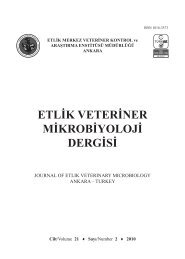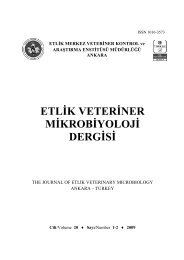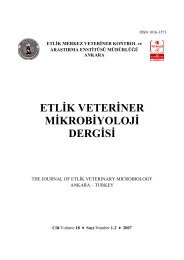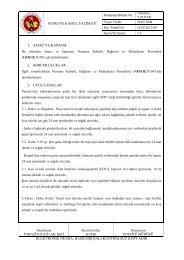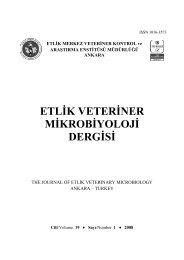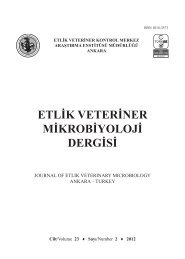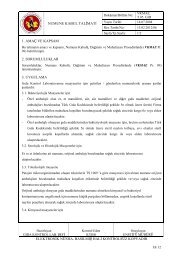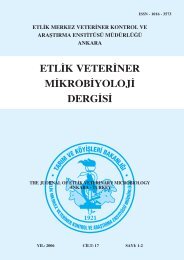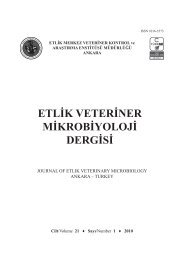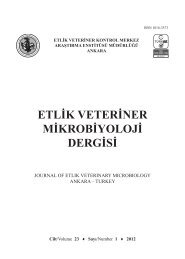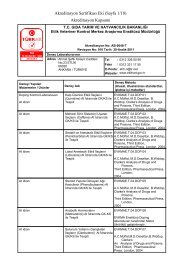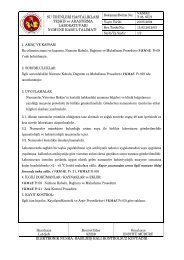etlik veteriner mikrobiyoloji dergisi - veteriner kontrol merkez ...
etlik veteriner mikrobiyoloji dergisi - veteriner kontrol merkez ...
etlik veteriner mikrobiyoloji dergisi - veteriner kontrol merkez ...
Create successful ePaper yourself
Turn your PDF publications into a flip-book with our unique Google optimized e-Paper software.
Sırıken B ve ark. Etlik Vet Mikrobiyol Derg, 22, 54-60, 2011 57<br />
Confirmation of the Enterococcus spp. by PCR<br />
analysis: For determination of Enterococcus spp. at<br />
genus level, extracted DNA was PCR-amplified using<br />
primers that target the tuf gene (elongation factor<br />
EF-Tu). For this purpose, Ent1 and Ent2 primers<br />
were used and amplification procedures were performed<br />
according to (20) (Table 1). E.faecalis ATCC<br />
29212 and S.aureus ATCC 29213 were used as positive<br />
and negative control strains, respectively.<br />
Species specific identification and determination<br />
of vancomycin resistance by multiplex PCR<br />
analysis: A multiplex PCR was performed to identify<br />
E.faecium and E.faecalis and detect the presence<br />
of van genes in these species. The primers for<br />
the amplification of species-specific D-Ala:D-Ala<br />
ligase genes (ddl genes) and van genes (vanA, van<br />
B, vanC1/2, van D, van E and van G) are presented<br />
in Table 1. These primers were selected and amplification<br />
was conducted as described by Depardieu et<br />
al. (9), after amplification, the DNA fragments were<br />
separated by agarose gel electrophoresis and visualized<br />
under ultraviolet (UV) light. E.faecalis ATCC<br />
29212 and E.faecium ATCC 19434 were used as<br />
control strains.<br />
Slime production: Slime production assay was performed<br />
by cultivation of Enterococcus spp. isolates<br />
on Congo Red agar (CRA) plates containing 0.8 g/l<br />
of Congo red dye and 50 g/l of saccharose (16). Isolates<br />
were streaked on the CRA plates and incubated<br />
at 37°C for 24-48 hrs. Slime production was evaluated<br />
observing the rough black (slime positive) or<br />
red (slime negative) colonies on CRA.<br />
Results<br />
In the present study, a total of 92 Enterococcus<br />
spp. were isolated from 41 (33.3%) out of the 123<br />
samples by direct culture on Slanetz and Bartley<br />
agar and verified by single PCR targeted tuf gene<br />
(Figure 1). Specifity was confirmed on positive and<br />
negative control strains. As expected, no band was<br />
observed for the negative control strain (S.aureus<br />
ATCC 29213) but the expected size of PCR products<br />
(476 bp) was observed for the positive control<br />
strain (E.faecalis ATCC 29212).<br />
In multiplex PCR performed to identify enterococci<br />
either being E.faecalis or E.faecium and to<br />
detect vancomycin resistance, the ddl gene specific<br />
for E.faecalis was detected in thirty-nine of 92 iso-<br />
lates (42.3%) and they were identified as E.faecalis,<br />
but no band was found specific for E.faecium (Figure<br />
2). The remaining isolates (57.6%) were evaluated<br />
as Enterococcus spp. except from E.faecalis<br />
and E.faecium. vanA, vanB, vanC1/2, vanD, vanE,<br />
vanG genes were also not detected in any of the isolates.<br />
None of the isolates was found slime positive<br />
on CRA.<br />
Figure 1. The single PCR results targeted tuf gene for the<br />
detection of Enterococcus species M: Marker; lanes1-2:<br />
Enterococcus species isolated from chicken carcasses<br />
Figure 2. The multiplex PCR results targeted ddl<br />
genes for the detection E.faecalis and E.faecium and<br />
vanA,B,C1/2,D,E and G for the detection vancomycine<br />
resistant Enterococcus species M: Marker; lane 2:<br />
ddl gene (476 bp) for the detection of E.faecalis ATCC<br />
29212; lane 3: ddl gene (1091 bp) for the detection of<br />
E.faecium ATCC 19434



